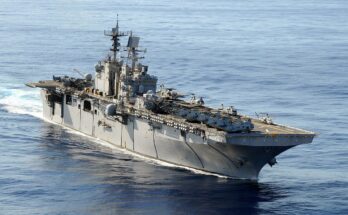
A year after Oct. 7, the Middle East is in the midst of one of its most widespread conflicts in recent memory, with new developments coming at a dizzying rate. Israel’s Netanyahu government has seized the moment to transform the response to Oct. 7 into a broader conflict to dismantle the Iranian-led anti-Israel alliance often known as the Axis of Resistance. As of October, Israel has zeroed in on the fight against the Lebanese Hezbollah militant group as a critical battleground in the fight to curb Iranian influence.
Threads To Tehran
Israeli strikes over the past year have targeted a variety of countries and groups but share one unifying factor: Iran. The Islamic Republic has for years sponsored armed groups and governments in the region that share its anti-Israel and anti-U.S. beliefs, strengthening its Axis of Resistance through arms and financing. In 2020, an Iranian Revolutionary Guard Corps (IRGC) commander estimated that Iran had spent almost $20 billion funding its foreign policy objectives and proxies in the region. Annual Iranian funding for armed groups like Hezbollah was estimated by the State Dept. as $700 million in 2018. Iran has supplied weapons to anti-Israel groups, including the missiles and unmanned aerial vehicles (UAVs) provided to the Yemeni Houthis which have been used to attack shipping and infrastructure in the Red Sea and in Israel itself. Though Iran has funded numerous groups across multiple countries, Hezbollah has been one of, if not the primary recipient for decades.
While Hamas may have perpetrated the Oct. 7 attack, the funding links between Iran and the Palestinian militant group as well as the broader network of armed anti-Israel groups in the region cause Israeli policymakers to trace the thread of security threats back to Tehran. Certain Israeli leaders view national security as unattainable without the severe curtailing, containment or confrontation of Iranian power in the region.
Prime Minister Netanyahu is certainly no stranger to this line of thinking, having consistently reiterated his opinion that the greatest threat to Israel is Iran. His current cabinet is stocked with many who share this belief, and following the events of Oct. 7, placed blame not only on the Hamas attackers but on Iranian leadership and others that supported them. Grievance over the Hamas massacre and subsequent rocket, missile and drone attacks has given the Netanyahu cabinet a mandate to respond, which it has taken not only in Gaza, but wherever it scents Iranian-linked threats, and there is perhaps no greater bastion of that threat than southern Lebanon.
Israeli Escalation In Lebanon
Netanyahu’s interest in dismantling Iran’s tendrils is best displayed in the expanding operation in Lebanon. Cross-border raids and strikes are a common feature of the Israeli-Lebanese border, however, the character of the current offensive, Operation Northern Arrow, is distinctly different than exchanges in the past decade. This was perhaps best reflected by the decision to strike and kill Hassan Nasrallah, long-time leader of the Lebanese militant group, Hezbollah, a significant escalation against the group, targeting one of Iran’s closest allies. The strike, as well as others targeting high-ranking Hezbollah members, demonstrated Tel Aviv’s intention to more seriously confront the group than in years past.
Despite Hezbollah’s non-involvement in the Oct. 7 attacks, the group has reportedly launched over 8,000 rockets at Israel over the past year in support of allied Hamas. Around 70,000 Israelis dwelling near the northern border have fled in the wake of the rocket attacks, some fearing an Oct. 7-style attack. The continued displacement of these citizens puts pressure on Netanyahu at home to act to return them.
More reminiscent of Israel’s 2006 Invasion of Lebanon, the current operation has already killed 2,000 people and displaced over a million in a country with a population of fewer than six million. Unlike previous smaller anti-Hezbollah operations, this offensive has involved the widespread targeting of sites across Lebanon, including the capital of Beirut, rather than limited attacks on Hezbollah strongholds in southern Lebanon as had been the case prior. The Israeli Air Force (IAF) has used jets, helicopters and drones to conduct over 1,100 strikes on Lebanon since Oct. 1 in a massive show of force meant to cripple the group’s operational ability.
The scale of Israeli Defense Forces (IDF) troop deployment also reflects the significance of this moment, with soldiers from four divisions contributing to the operation, likely numbering in the thousands, with speculations of up to 15,000 involved. While currently limited in deployment, the operation is overwhelmingly the largest in the area since 2006, reflecting Israeli leadership’s view of the offensive not only as retributive or disciplinary but as an opportunity to destroy the Iranian-backed Hezbollah thorn in the country’s side and prevent Tehran from projecting power from Israel’s north. Leadership has stated the intention to dismantle Hezbollah infrastructure such as missile launching sites, bunkers and bases on the border, however, given the scope of deployment, the capacity for escalation into a wider anti-Hezbollah push deeper into Lebanon is plausible.
Israel has demonstrated the capability to damage Hezbollah to shocking degrees, however, to eradicate the deeply rooted group fully would require a significant commitment to action in Lebanon which could prove damaging for Israel and Lebanon alike. A smaller effort to remove missile-launching and command infrastructure or establish a renewed U.N. or Israel-backed buffer zone on the border could be more feasible, however, such a resolution would fail to accomplish the goal of dissolving or permanently crippling Hezbollah. A U.N. backed demilitarized zone is already technically in effect in southern Lebanon via U.N. Security Council Resolution 1701 which ended the 2006 War, banning Hezbollah and Israeli armed forces along the border. The resolution, however, has largely failed to be enacted in full, with Hezbollah remaining active on the border region, and Israel routinely breaching Lebanese airspace. In the eyes of the Netanyahu government, settling for perceived half-measures and guarantees from outside actors may not be satisfactory.
* * *
Israel’s deepening conflict in Lebanon represents a critical escalation in its efforts to dismantle the Iranian-led Axis of Resistance, with Hezbollah at the forefront of the struggle. Operation Northern Arrow, marked by extensive airstrikes and the deployment of thousands of troops, aims to significantly weaken Hezbollah’s military capabilities and curtail Tehran’s influence in the region. While Israel has the power to severely damage Hezbollah, fully eradicating the group would require a long-term commitment to military action in Lebanon, risking greater instability and a potentially prolonged conflict.
Tom Freebairn is a weapons analyst with Military Periscope covering naval affairs and maritime systems. He pursued an undergraduate degree in International Relations and Modern History, followed by a master's in Middle East, Caucasus, and Central Asia Security Studies from the University of St. Andrews. His master's thesis focused on the relationship between oil and separatist politics in Northern Iraq. Tom's interests include the politics of energy, ethnic separatism, the evolution of naval warfare, and classical history.




